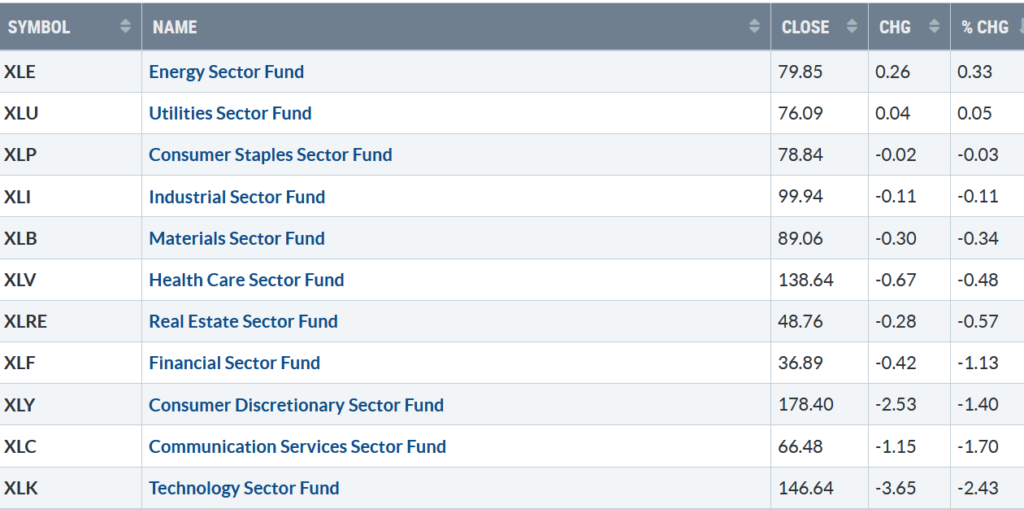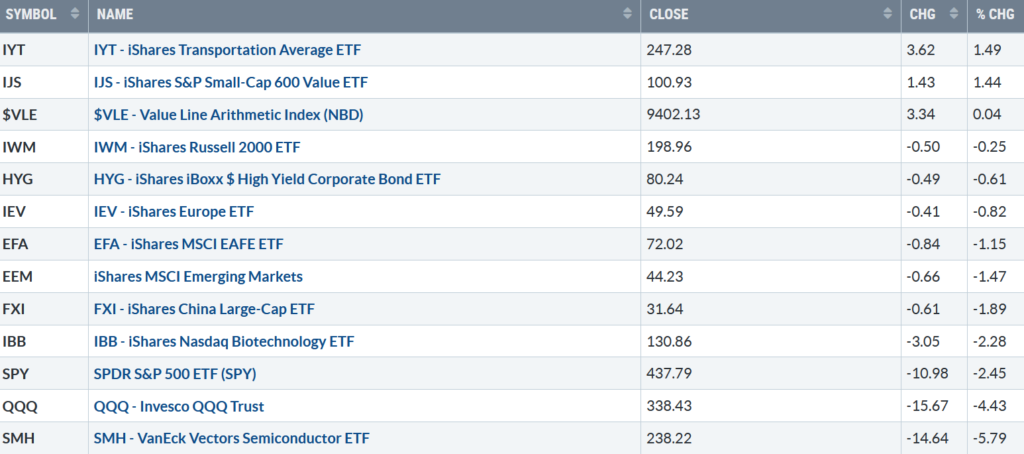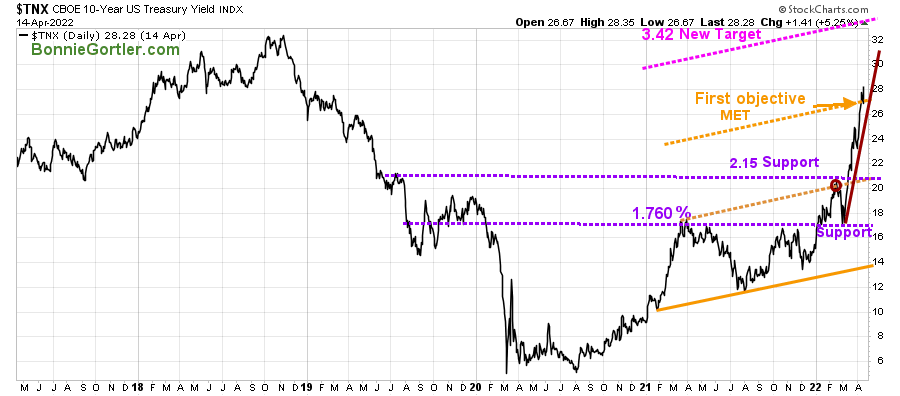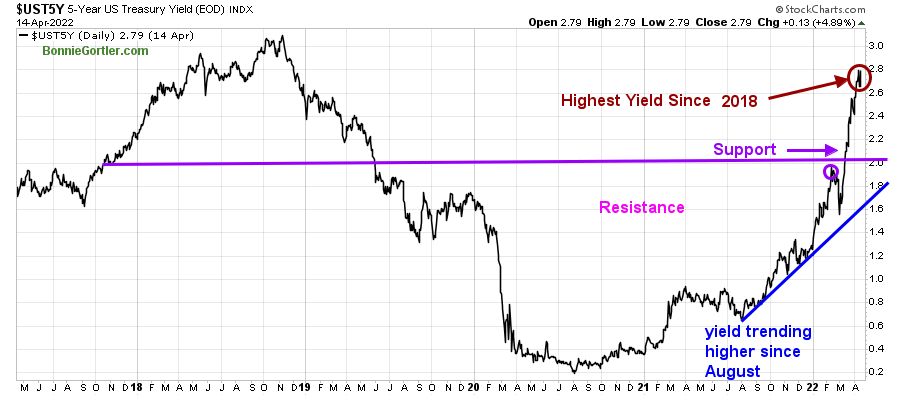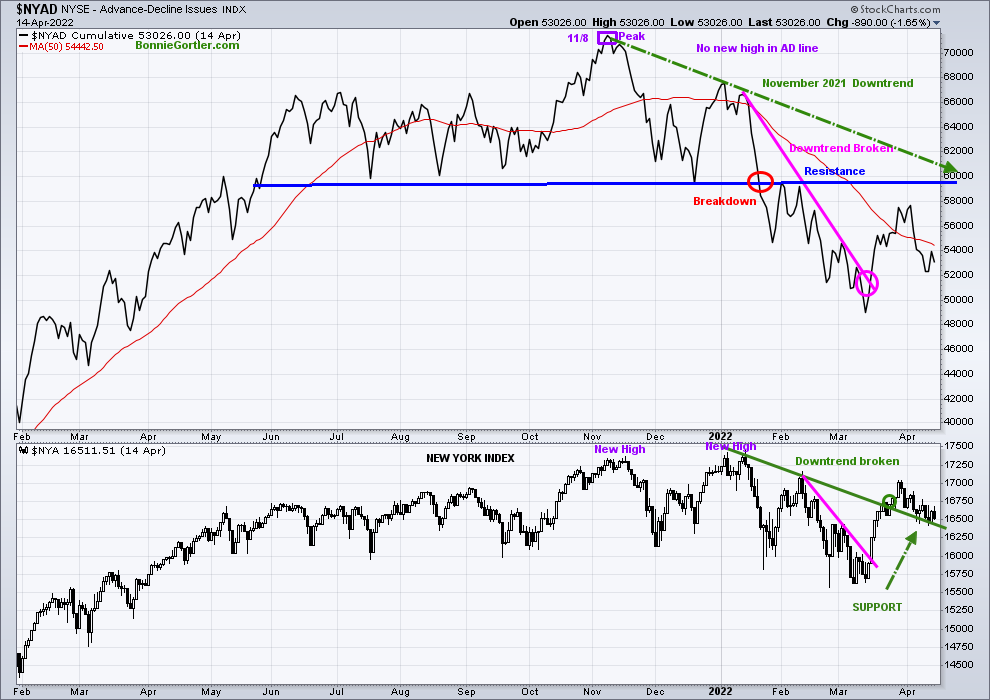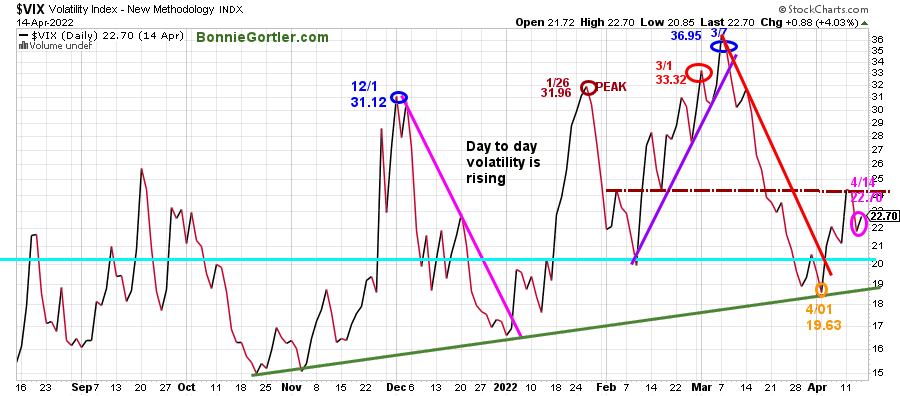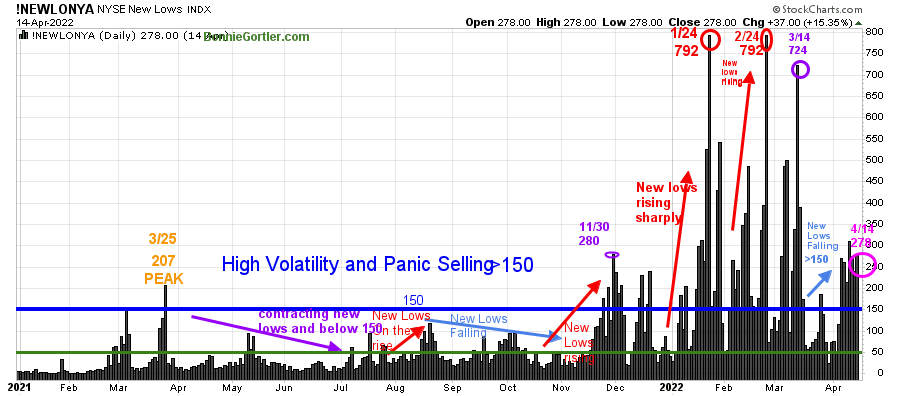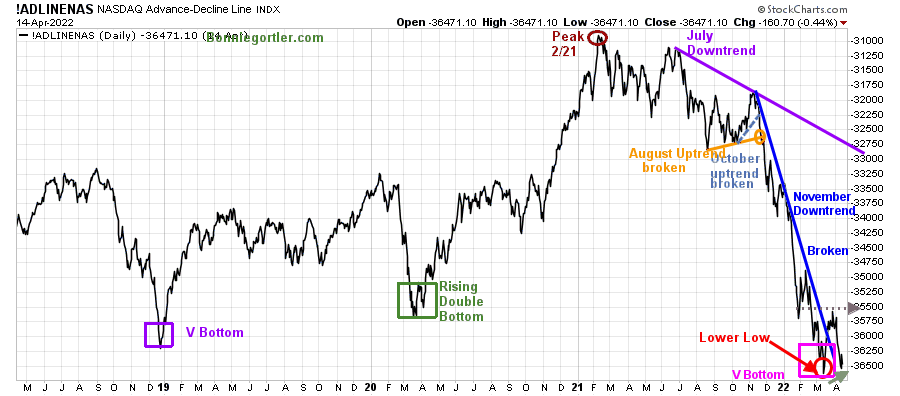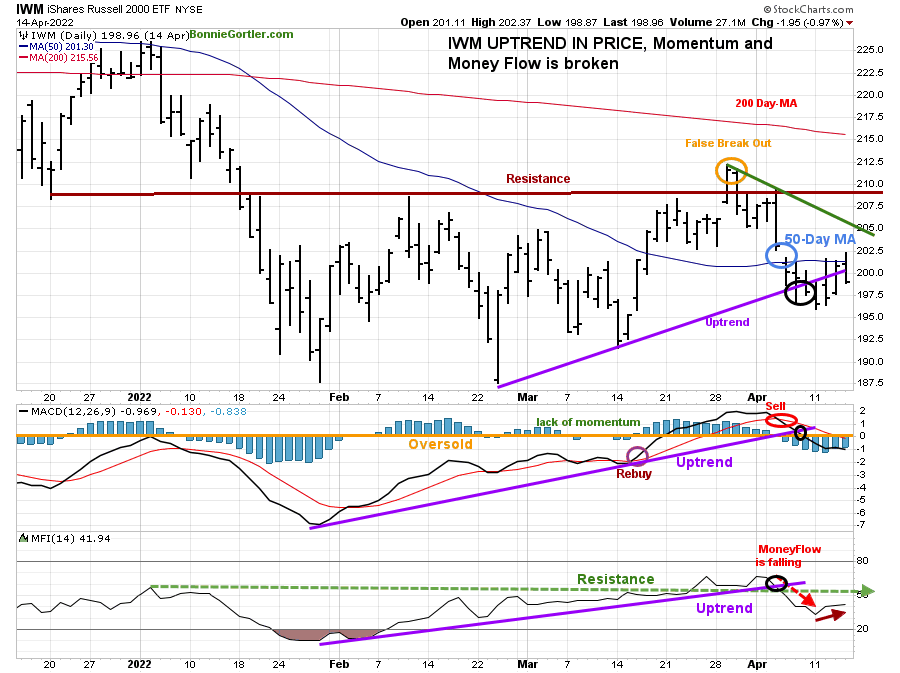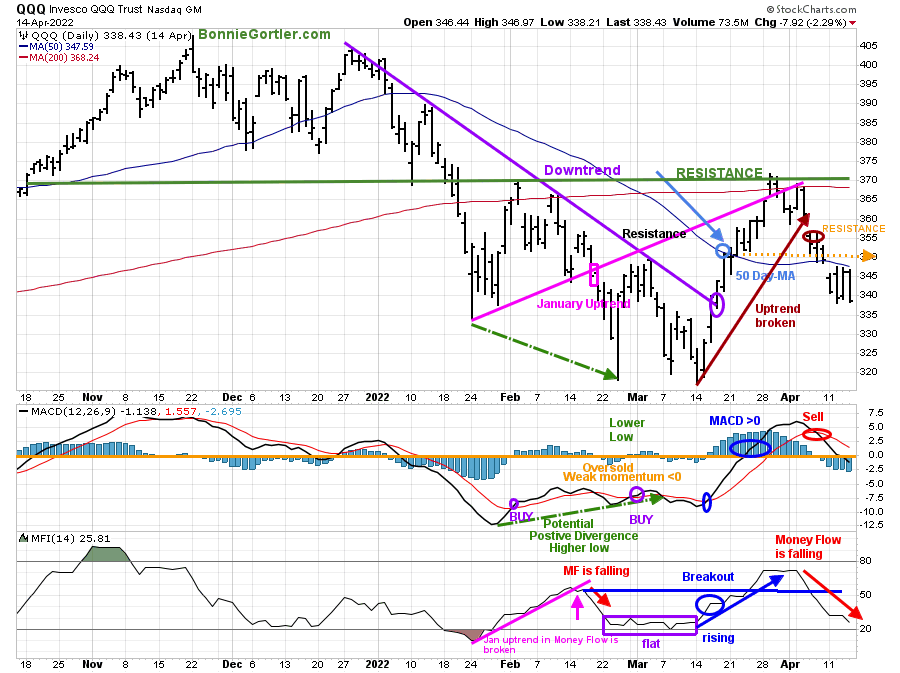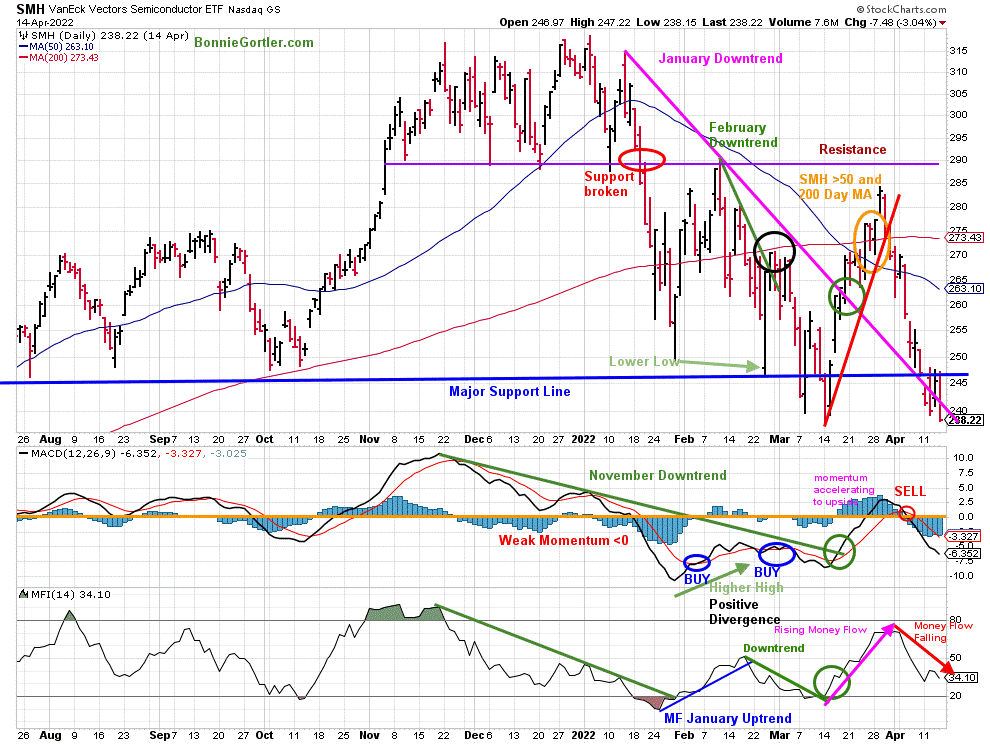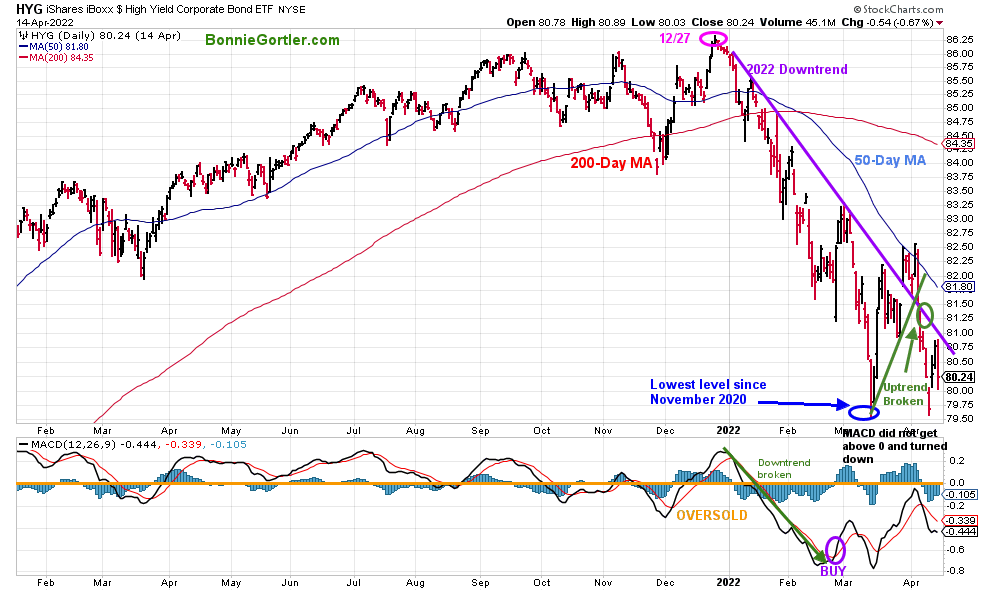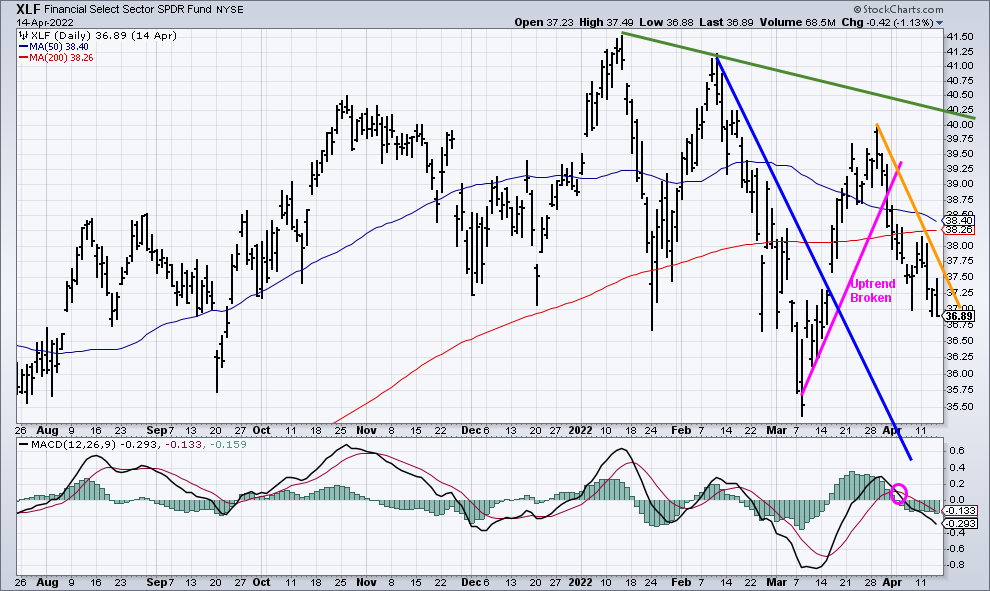Market Update 4/14/22
Weakness continues. Two of the eleven S&P SPDR sectors rose. Energy (XLE) and Utilities (XLU) were the best performing sectors, while Consumer Services (XLC) and Technology (XLF) were the weakest. The SPDR S&P 500 ETF Trust (SPY) was down -2.19 %.
4/7/22 – 4/14/22
S&P SPDR Sector ETFs Performance Summary
Source: Stockcharts.com *Performance Data 4-day week due to holiday
Figure 2: Bonnie’s Mix of ETFs
Performance Summary 4/7/22 – 4/14/22
Source: Stockcharts.com *Performance Data 4-day week due to holiday
Transports reversed higher, Small Cap Growth and Small Value stabilized. Global markets remained weak. Semiconductors and Technology continued to trend lower and remain under heavy selling pressure as yields rose again.
Figure 3:UST 10 YR Bond Yields Daily
Source: Stockcharts.com
The 10-Year U.S. Treasury yields continued to climb last week to three-year highs closing at 2.828%, closing above my upside objective, and giving a new upside target of 3.42.
Figure 4: UST 5 YR Bond Yields Daily
Source: Stockcharts.com
The 5 Year U.S Treasury yield rose, closing at 2.79%.
The Dow fell -0.78% for the week, the least of the major averages. The S&P 500was down -2.13%, Nasdaq fell -2.63%, while the Russell 2000 Index bucked the trend gaining +0.52 %.
The Value Line Arithmetic Index (a mix of approximately 1700 stocks rose +0.18%.
Weekly market breadth remained negative for the New York Stock Exchange Index (NYSE) and Nasdaq. The NYSE had 1622 advances and 1948 declines, with 227 new highs and 511 new lows. There were 2231 advances and 3039 declines on the Nasdaq, with 236 new highs and 678 new lows.
Figure 5: NYSE Cumulative Advance-Decline Line (Top) and NYSE Index (Bottom)
Source: Stockcharts.com
The New York Index made a new high in November 2021 and in January 2022 (bottom chart), unconfirmed by the NYSE AD line, which peaked on 11/8/21 (purple rectangle top chart).
The NYSE A/D Line remains in a downtrend (green dotted line top chart).
In March, the AD Line and New York Index broke their downtrends (pink line top and bottom chart). Its negative breadth weakened in April, turning down failing to get above resistance (blue line top chart). Improved market breadth is needed for a rally in the second quarter of 2022 to be sustainable. Keep a close eye for more advances than declines and New Lows contracting below 150.
Figure 6: CBOE Volatility Index VIX
Source: Stockcharts.com
The CBOE Volatility Index ($VIX), a measure of fear, has been trading above 20.00 for most of 2022. In January, VIX made a high at 31.96 on 1/26 (brown circle), on 3/1 at 33.32 (red circle), and 36.95 on 3/7 (blue circle).
VIX rose last week, closing at 22.70 on 4/14, after falling below 20 on 4/01 (orange circle) at 19.63. If VIX continues higher, expect day-to-day volatility to increase, especially if VIX closes above 24.00.
Figure 7: Daily New York Stock Exchange (NYSE) New Lows
Source: Stockcharts.com
Watching New lows on the New York Stock Exchange is a simple technical tool that helps awareness of the immediate trend’s direction.
New lows warned of a potential sharp pullback, high volatility, and “panic selling” for most of 2022, closing above 150. Learn more about the significance of New Lows in my book, Journey to Wealth, published on Amazon. Here is an excerpt, when new lows are above 150, the market is negative, higher risk, and selling is taking place. Sometimes it could be severe, and sometimes on a very nasty day, you can have “panic selling,” and big wild swings (high volatility) to the downside may occur.
As the market sold off in January, New Lows rose sharply, peaking at 792 on 1/24 (red circle), and then contracted but not enough to be in a low-risk zone before rising again on 2/24 at 792, matching the 1/24 peak. In March, New lows fell below 150, and a short-term rally began. However, it’s worrisome they remain above 150 and are not contracting.
New Lows closed at 278 on 4/14 (pink circle), remaining above 150, not a positive sign in the near term. Risk is high of further downside in the near term until they contract to below 150 and then fall between 25 and 50.
Figure 8: Daily Nasdaq Advance-Decline Line
Source: Stockcharts.com
The daily Nasdaq advance-decline line peaked in February 2021 (brown circle), followed by failed attempts to make a new high. After breaking the October uptrend (blue dotted line), the Nasdaq AD-Line made a series of lower highs and lower lows in November, December, and January and trended down.
The July 2021 downtrend (purple line) remains. After making a lower low earlier in the month, a V bottom identical to December 2019 (purple rectangle) formed. The downtrend from November (blue) penetrated was a positive sign that the worst of the decline is over. However, with last week’s negative breadth, the AD line turned down and is close to making a lower low. Further weakness below the low would imply a potential of a new leg down.
Figure 9: Daily iShares Russell 2000 (IWM) Price (Top) and 12-26-9 MACD (Middle) and Money Flow (Bottom)
Source: Stockcharts.com
The top portion of the chart is the daily iShares Russell 2000 Index ETF (IWM), the benchmark for small-cap stocks, with a 50-Day Moving Average (MA) (blue line) and 200-Day Moving Average (MA) that traders watch and use to define trends.
IWM had the potential to break out to the upside, but in late March, IWM had a failed breakout above resistance at 210.00 (orange circle).
The previous week IWM was under heavy selling pressure after gapping below the 50-Day MA (light blue circle), followed by IWM breaking the uptrend (black circle). However, last week there was no follow-through to the downside, with IWM holding above 195.00 support but no real upside strength shown, closing at 198.96, up +0.55%.
Short-term resistance is 205.00, 210.00, and 212.50. Support remains at 195.00 and 192.00.MACD (middle chart) remains on a sell.
Money Flow (lower chart) broke the uptrend in early April, and it appears to have bottomed, but a continued rise in Money Flow is needed for this trend to remain.
NOTE: IWM for the intermediate term (weekly chart not shown) stalled under resistance at 210.00 after generating a buy. However, it concerns me that the downtrend in MACD remains.
Nasdaq remains weak in a short-term trend down.
Figure 10: Daily Invesco QQQ Trust (QQQ) Price (Top) and 12-26-9 MACD (Bottom)
Source: Stockcharts.com
The chart shows the daily Invesco QQQ, an exchange-traded fund based on the Nasdaq 100 Index with its 50 and 200-Day Moving Average. QQQ accelerated lower after breaking the January uptrend (pink rectangle), penetrating the January lows, then stalled at 351.00 resistance in early March and turned lower.
Last week QQQ fell by -3.07%, closing at 338.43, below its 50-Day and 200-Day Moving Average. The short-term trend remains down after breaking the March uptrend (brown line) at 355.00.
Resistance is between 350 and 355.00, followed by 370.00. Support is at 330.00 and 320.00.
The middle chart is MACD (12, 26, 9), a measure of momentum, remains on a sell
Money Flow (lower chart) continues down after breaking out of its sideways trading range after reaching its highest level since November 2021.
With the short-term trend down, caution is recommended until price, momentum, and money flow turn up.
Figure 11: Van Eck Semiconductors (SMH) Daily Price (Top), 12-26-9 MACD (Middle), and Money Flow (Bottom)
Stockcharts.com
SMH in 2022 has been volatile. In late January, support was broken (red circle) and then fell sharply but held the October 2021 lows. SMH then rallied but turned down again, closing below support at 240.00 on 3/14/22, a false breakdown.
Underperformance in SMH compared to QQQ gave a warning of pending weakness. SMH broke the March uptrend (red line) after failing to get above resistance and fell sharply for a third week, down -3.50%, closing at 238.22.
Support is at 235.00, 220.00, and 210.00. Resistance is at 250.00 and 265.00.
MACD (middle chart) is on a sell (red circle), and Money Flow (lower chart) is trending down and is falling. SMH is likely to test the March lows early next week with the short-term trend down. Until MACD and Money Flow stop falling, it remains risky to bottom fish at this time.
Figure 12: I Shares Hi Yield Corporate Bond (HYG) (Top), and 12-26-9 MACD (Bottom)
Source: Stockcharts.com
Hi-Yield Bonds (HYG) peaked on 12/27/21 and appeared to stabilize in late February but reversed lower, reaching their lowest level since November 2020 (blue circle).
HYG remains below its 50 Day MA and is not showing much strength after breaking the downtrend, closing at 80.24, unchanged for the week. Another test of the March low is possible.
MACD did not get above 0 and turned down, implying weak momentum. More base building is needed. Monitor the performance of HYG. A potential double bottom could occur if HYG shows strength and closes above 81.50 and then 82.10.
Figure 13: Financial Select SPDR (XLF) (Top) and 12-26-9 MACD (Bottom)
Source: Stockcharts.com
The short-term trend in Financials (XLF) remains down after no real upside strength and breaking its March uptrend (pink line) and closing below its 50 and 200 Day- MA.
Even though rates rose, Financials (XLF) fell by -2.64% last week.
MACD is on sell, below 0, and falling. Until XLF trades above 38.75 and MACD turns up, the risk remains of further downside.
Summing Up:
The major averages continued lower on poor market breadth, making it harder for a rally to be sustainable. Inflation data for the second month showed sharply rising prices. Treasury yields continue to climb higher, fueling continued selling in the technology sector. Short-term momentum patterns remain concerning, not yet favorable enough to signal that an upside reversal would be sustainable is forthcoming soon. Risk has increased of further decline in the near term until proven otherwise.
Remember to manage your risk, and your wealth will grow.
If you liked this article, you will love my Free Grow and Sustain Your Wealth Report. Get it here:
Do you like charts, I invite you to my FB group Wealth Through Market Charts or email me at Bonnie@Bonniegortler.com.
I would love to hear from you. If you have any questions or comments or would like to talk about the market, click here.
Disclaimer: Although the information is made with a sincere effort for accuracy, it is not guaranteed that the information provided is a statement of fact. Nor can we guarantee the results of following any of the recommendations made herein. Readers are encouraged to meet with their own advisors to consider the suitability of investments for their own particular situations and for determination of their own risk levels. Past performance does not guarantee any future results.


